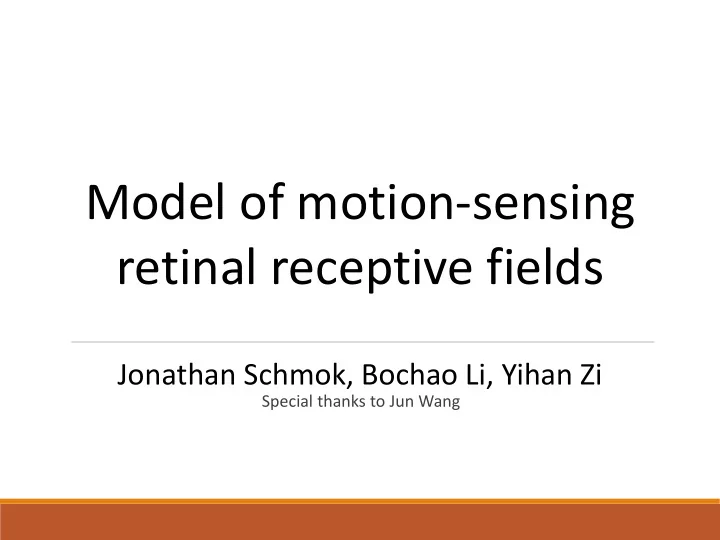

Model of motion-sensing retinal receptive fields Jonathan Schmok, Bochao Li, Yihan Zi Special thanks to Jun Wang
The Retina - Directionally Sensitive(DS) Cells Why this project? Study of information coding in retina output firing pattern
Reichardt-Hassenstein Model
RH Model with Neurons SYNAPSE MODEL NEURON MODEL Gap Junctions Leaky-Passive Neurons Chemical Synapse Hodgkin-Huxley Neuron
The Network rod 0 rod 1 𝜐 neuron 𝜐 neuron arithmetic arithmetic neuron neuron output neuron
Input Time Rod 0 Rod 1 Rod 0 Rod 1
Rods Model: Leaky Passive Neurons 𝑒𝑤 𝑒𝑢 = 𝐽 𝑓𝑦𝑢 − 𝑀 ∗ 𝑊 − 𝐹 𝑆 𝐷 𝑛 Parameter Value Capacitance 10 uF/cm^2 Leak Conductance 0.3 mS/cm^2 Resting Potential 0 mV Input:
𝜐 Neurons Model: Leaky Passive Neurons 𝑒𝑢 = 𝐽 𝑏𝑞 − 𝑀 ∗ 𝑊 − 𝐹 𝑆 𝑒𝑤 𝐷 𝑛 Parameter Value Capacitance 250 uF/cm^2 Leak Conductance 0.3 mS/cm^2 Resting Potential 0 mV Input: • Time delay from large capacitance • Representing high surface area starburst amacrine cells
Arithmetic Neurons Model: Leaky Passive Neurons 𝑒𝑢 = (𝐽 𝑏𝑞1 ∗ 𝐽 𝑏𝑞2 ) − 𝑀 ∗ 𝑊 − 𝐹 𝑆 𝑒𝑤 𝐷 𝑛 Parameter Value Capacitance 10 uF/cm^2 Leak Conductance 0.3 mS/cm^2 Resting Potential 0 mV • Gap junction from input and tau neurons • Multiplication in neurons active area of research
Output Neuron Model: Hodgkin-Huxley Neuron 𝑒𝑢 = 𝑀 ∗ 𝐹 𝑀 − 𝑊 + 𝐽 𝐹𝑦𝑑𝑗𝑢𝑏𝑢𝑝𝑠𝑧 − 𝐽 𝐽𝑜ℎ𝑗𝑐𝑗𝑢𝑝𝑠𝑧 − 𝑂𝑏 𝑛 3 ℎ 𝑊 − 𝐹 𝑂𝑏 − 𝐿 𝑜 4 𝑊 − 𝐹 𝐿 𝑒𝑤 𝐷 𝑛 • Parameter Value Excitatory synapse from left arithmetic unit and inhibitory synapse from right Capacitance 10 uF/cm^2 arithmetic unit define preferred and null 𝑀 0.3 ms/cm^2 direction 𝐹 𝑀 -65 mV 𝑂𝑏 100 mS/cm^2 • 𝐹 𝑀 determined manually for optimal 𝐿 30 mS/cm^2 discrimination – other parameters from 𝐹 𝑂𝑏 40 mV physiological measurements 𝐹 𝐿 -90 mV
Reichardt-Hassenstain model outputs of DS cells Null Direction Preferred Direction
Neural RH model of DS cells Null Direction Preferred Direction • DS cells fire at their preferred direction and depolarize at null direction • Firing rate slowing down match natural neurons response stronger at the edge of signal
Model analysis- input amplitude contrast Period=500 0.2 0.18 0.16 0.14 Spke interval 0.12 0.1 0.08 0.06 0.04 0.02 0 0.3 0.5 1 2.5 5 7.5 10 12.5 15 input contrast
Model analysis- velocity Period=500 Period=200 0.2 0.09 0.18 0.08 0.16 0.07 0.14 Spke interval 0.06 Spike interval 0.12 0.05 0.1 0.04 0.08 0.03 0.06 0.04 0.02 0.02 0.01 0 0 0.3 0.5 1 2.5 5 7.5 10 12.5 15 0.3 0.5 1 2.5 5 7.5 10 12.5 15 input contrast input contrast Period=50 0.06 Contrast for Spike 0.05 0.04 SPike interval 0.03 Spike interval responds to velocity 0.02 0.01 0 0.3 0.5 1 2.5 5 7.5 10 12.5 15 input contrast
Future Studies ◦ How do neurons perform multiplication? ◦ Design a model that is directionally sensitive in 2+ dimensions ◦ Retina inspired computer vision ◦ More complex neuronal models with spatial geometry
Recommend
More recommend